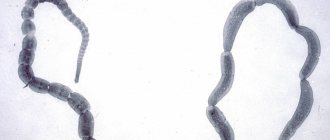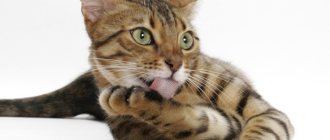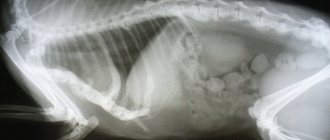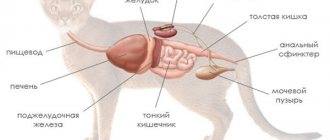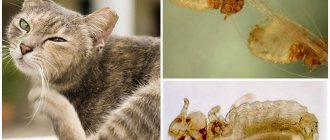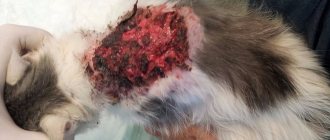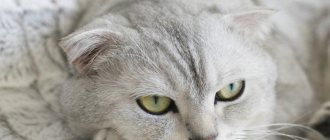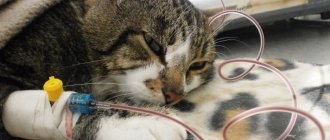Many people make a lot of efforts to get rid of extra pounds, but for some reason they are touched by the sight of a fat, imposing cat. But the problem of excess weight for cats is as acute as for their owners. Excessive fat deposits in the subcutaneous tissue, various organs and tissues are the result of overfeeding, low physical activity and threaten the development of many dangerous diseases, disability and even death of the animal. We must understand that obesity in cats is not a reason for delight and tenderness, it is a serious pathology. A sick animal needs proper treatment. From this article you will learn how to determine if a pet is obese, what to do to get rid of excess weight, and how to deal with the complications that this disease entails.
Types of obesity
In cats (as in people), depending on the causes, there are two types of obesity - primary and secondary.
- Primary obesity is also called nutritional obesity. It is based on incorrectly formed dietary preferences, leading to an energy imbalance in the body, as well as hereditary-constitutional factors (inheritance of a tendency to be overweight from ancestors). This type of obesity in cats is an independent disease that can be treated.
- Secondary obesity is called symptomatic. It is only a symptom of a malfunction of other organs (most often the brain or endocrine glands), as a result of which the metabolic rate changes and a pathological appetite appears. In this case, it is not obesity itself that needs to be treated, but its root cause.
Symptoms
Every cat owner should know what obesity is and how to correctly identify it in their pet. Obesity is a consequence of metabolic disorders and occurs when weight increases by 20% of the norm according to the breed standard.
When calculating, it is important to take into account the sex and age of the animal. This is due to the fact that young cats during the period of active growth can gain weight and then safely lose it. The same applies to gender - males, as a rule, are much larger than females. The ideal indicator is weight at the age of one year.
The main symptoms of obesity are as follows:
- sagging in the abdominal area;
- fat deposits on the side of the body;
- leisurely gait;
- apathetic state of the pet and drowsiness;
- development of shortness of breath during active physical activity (running, jumping).
A sign of obesity in a cat can be considered the appearance of folds in the ribs and abdomen. By carefully palpating your mustachioed pet, the owner will be able to note the presence of fatty deposits. Also, excess weight is visually noticeable in cats, especially if the cat at the age of 1 year did not have a large build.
Causes
There are several main reasons why cats develop obesity:
- energy imbalance (predominance of the amount of incoming energy over the energy expenditure of the body);
- lipid imbalance (the predominance of the amount of fat consumed over the body’s ability to burn it);
- metabolic disorders and hormonal imbalances in the body;
- burdened heredity.
Provoking factors
There are also certain factors, the presence of which provokes obesity in cats:
- overfeeding the animal;
- low physical activity;
- unbalanced diet;
- sterilization or castration of animals;
- endocrinological diseases;
- hormonal therapy and the use of oral contraceptives;
- breed and genetic predisposition;
- senior and old age.
Overfeeding an animal
The most common risk factor for a cat leading to obesity is overfeeding the animal in combination with physical inactivity. By nature, a cat is a predator that must hunt for food, expending a lot of energy.
The problem with most furry pets living in city apartments is their extremely limited living space. The animal is deprived of the opportunity to run around, hunt, and play to its heart's content. In addition, to get food, he does not need to spend a single calorie - he can just come up and eat. Excessive comfort turns out to be evil, not good, for cats.
Overeating can be the result of certain lifestyle features:
- Rivalry between animals when several pets live under one roof.
- Lack of attention from the owners. The cat “eats” its feeling of “abandonment,” uselessness and loneliness.
- Food becomes a constant visual irritant if the owner prefers to constantly pour food into the cat's bowl. As the animal passes by, it sees food and cannot resist eating. As a result, daily feed consumption is many times higher than the average daily requirement.
- Bad habit. If, as a kitten, the animal was fed “to its fullest”, then over time the habit of overeating develops into a need, since the walls of the stomach stretch, accepting more and more.
Unbalanced diet
In obesity, an unbalanced diet is often the trigger. It is as follows:
- Animals are fed cheap feed that contains ingredients that are harmful to health.
- Some owners pamper their cats with food from their table, without thinking that it contains unacceptable amounts of carbohydrates and fats.
- A mixed diet consisting of both dry food and natural products can lead to obesity. When compiling a diet, it is recommended to choose one option: natural balanced nutrition or high-quality dry food. Natural nutrition should be varied and include the required amount of proteins, fats, carbohydrates, minerals and vitamins.
- When using industrial feed, the daily allowance indicated on the packaging in a special table is often exceeded.
Sterilization
After sterilization, hormonal imbalance may occur, which can lead to obesity. Danger exists only if you do not pay enough attention to the animal. The energy that was previously spent on finding a partner and sexual games must now be spent in a different way.
Therefore, the owner of a sterilized cat must ensure that the animal moves a lot, provide it with the opportunity and territory to play, and also use special low-calorie food.
Endocrinological diseases
They are associated with metabolic disorders and hormonal imbalances, which also, under certain conditions, lead to obesity. Such diseases include:
- diabetes mellitus, in which insulin production decreases, its activity decreases, or its perception by tissue cells is impaired;
- hypofunction of the thyroid gland, characterized by a slowdown in metabolism, increased synthesis and accumulation of adipose tissue, and a decrease in physical activity;
- Gastrointestinal pathologies and adrenal dysfunction are also dangerous.
Hormonal therapy and the use of oral contraceptives
This is another reason for serious hormonal imbalances, which are the causes of excess weight. In addition, other health problems, including malignant neoplasms, may occur as side effects.
Breed and genetic predisposition
There are cat breeds whose breed quality is a tendency to be overweight and have an increased appetite. An example is the British Shorthair. A balanced diet is very important for this breed. The diet should consist of specialized feeds with moderate calorie content. If this rule is not followed, obesity will be difficult to avoid.
The tendency to the disease can be inherited. Therefore, when choosing an animal, before purchasing, you should definitely ask the breeders what chronic ailments and abnormalities bothered its parents and earlier ancestors.
Senior and old age
At an older age, the animal’s physical activity gradually decreases and metabolism slows down. Starting from the age of five, it is necessary to especially carefully ensure that the pet maintains an energy balance between the energy received and expended, otherwise obesity in an elderly cat is highly likely to occur.
Proper nutrition
When a pet appears in the house, you will be faced with the question of what type of food you will prefer. You can opt for natural products or buy industrial feed. In this case, the prepared food must be premium or super-premium.
If you prefer natural feeding, then your four-legged friend’s menu should include the following products:
- Boiled sea fish.
- Meat without bones and skin (rabbit, turkey, beef, chicken).
- Low-fat dairy products (up to 5% fat).
- Vegetables and fruits in moderation.
- By-products are allowed no more than twice a week (peeled and boiled).
Don't forget about mineral supplements and vitamins. They should be present in the diet regularly. It is difficult to correctly calculate the volume of products offered to an animal. After all, all pets are different and lead different lifestyles, so they require different portions of food. In general, by experience you can learn to determine whether your pet has enough food. If the cat does not finish the portion, the leftovers must be removed so as not to disrupt the diet and prevent overeating.
With ready-made food, it is much easier to determine food intake norms. The packaging indicates how much food the animal needs based on age and weight. If the owner gives more food than necessary, the pet will begin to gain weight.
We suggest you read: What vaccinations does your Chihuahua need?
Dietary food for cats with obesity is the basis of treatment. Experts note that animals should never be given dietary supplements intended for humans.
For pets who are accustomed to eating canned food, we can recommend Purina Veterinary Diets OM Obesity Feline. They promote weight loss due to their low calorie content. This food is also good for pets suffering from diabetes, constipation, colitis and other ailments. Its peculiarity is that it contains a lot of fiber and virtually no fat.
It often happens that animals get used to one type of food, so the owners cannot change the manufacturer. As a result, an unbalanced diet leads to problems. And yet you have to change your usual diet. To make the transition less painful, you can use food for cats prone to obesity from the manufacturer that your pet likes. Typically, high-quality food lines contain dietary types.
Hills Presciption Diet Feline has proven itself well. It prevents obesity, constipation, and colitis. It is good even for diabetes. It contains a lot of fiber, significantly reduced fats and carbohydrates, but added L-carnitine. The food also contains vitamins A, E and D, minerals - phosphorus, calcium, potassium, sodium, magnesium, which help strengthen the immune system.
Diet is the basis of obesity treatment. But it is worth remembering that the pet must return to its normal weight smoothly and slowly, without compromising its health.
Another good food for treating obesity is Royal Canin Obesity. It contains the right ratio of nutrients that will help you lose weight. For the health of joints that experience extra stress due to excess weight, chondroitin and glucosamine are added. And for healthy skin and a beautiful coat, the food contains fatty acids (Omega-3 and Omega-6).
It is very important to remember one feature of dietary foods. All of them are contraindicated for pregnant cats. They should not be given during lactation.
Why is obesity dangerous?
Obesity is dangerous because it has many complications. It's not for nothing that they call it a ticking time bomb. After all, it affects not only the subcutaneous tissue. Fat is deposited in blood vessels and internal organs, impairing their functioning. This disease significantly shortens the animal's life. The main complications concern the following internal organs and systems:
- The cardiovascular system. An obese heart cannot withstand the load. It takes a lot of effort to lift and move a heavy body, as does pumping blood through vessels clogged with atherosclerotic plaques. That is why the risk of hypertension, heart attacks and other heart ailments increases several times.
- Diabetes. An incorrectly formulated diet, with a high content of carbohydrates, becomes the cause of many endocrinological diseases, including diabetes. In the later stages, the disease has very serious complications, such as visual impairment, even blindness, as well as the problem of tissue regeneration.
- Arthritis. Too much stress on the joints leads to their deformation and inflammation. The articular cartilage gradually wears out and loses its motor function.
- Obesity takes a toll on the liver. The cells of the organ begin to degenerate into fat cells. Fatty hepatosis leads to disruption of metabolic, barrier, and digestive functions.
- In the presence of other associated factors, obesity significantly increases the risk of developing malignant neoplasms.
What are the dangers of being overweight in cats?
Well-fed mustaches cause affection and even become the pride of the owner. In fact, extra pounds are a reason to think about the future fate of your pet.
Furry friends, just like humans, experience many problems due to obesity. Fat deposition leads to the development of:
- pathologies in the liver;
- dystrophy of internal organs;
- diabetes mellitus;
- diseases of the musculoskeletal system;
- idiopathic cystitis;
- cardiovascular diseases;
- blockage of blood vessels.
The list goes on, but often diseases are interconnected. For example, problems with joints and bones lead to a sedentary lifestyle. Because of this, the kilograms are added even more. It turns out to be a vicious circle, initially provoked by obesity.
Changes in the fat man’s behavior are also noticeable. He turns into a sluggish, apathetic creature, whose main desires are only food and sleep.
Perhaps the most important danger is shortening the pet’s life. A fat dog with chronic diseases will live 2-3, or even 5 years less than a fit and active pet.
How to determine if you are overweight
An external examination will help determine the degree of fatness of a pet. Signs of obesity are immediately visible:
- An emaciated cat will have an elongated body with a narrow back, sunken sides and belly, and protruding ribs and hip bones.
- A smooth body without prominent ribs and pelvic bones, which can be easily palpated, indicates normal fatness. The animal has a visible waist - a narrow place in the lumbar region. The abdomen is tucked, the subcutaneous fat layer is small.
- Obesity is indicated by an oval or spherical body. There is no waist. In the area of the spine, costal and pelvic bones there is a thick fatty layer that prevents palpation. You may notice a drooping belly.
But the clearest sign of obesity is weight. Knowing the average normal weight for cats of the corresponding breed, the owner during weighing can easily understand whether the body weight of his pet is much exceeded.
In order to exclude the presence of secondary (symptomatic) obesity, it is necessary to show your pet to a veterinarian. During the diagnosis, it will be clear whether obesity is an independent deviation (which can be corrected), or a symptom of another disease (when the animal will require more serious complex treatment).
Treatment of the disease
Primary obesity must be corrected by lifestyle changes, aimed mainly at introducing a healthy diet and increasing the animal’s physical activity. Let's talk in more detail about the most important steps:
- Review of diet. A special low-calorie diet is introduced, which in no case should be hungry. Otherwise, the effect will be the opposite, since in conditions of hunger the body retains adipose tissue and consumes it last. You can disrupt the functioning of the gastrointestinal tract without solving the problem of excess weight. Nutrition should be complete. Regardless of what kind of food the animal consumes, natural or industrial, the calorie content should decrease very gradually, over 1-2 months. When feeding a natural diet (as general recommendations), it is suggested to give the cat low-fat sea fish or lean meat, fermented milk products, and a limited amount of vegetables.
- Introduction of fractional meals. The cat should eat 5-6 times a day, in small portions. This will improve the digestibility of food. In addition, the cat will not be tormented by hunger, and a good mood is the key to successful treatment.
- Active lifestyle. It is necessary to stimulate the animal to play outdoor games, sometimes even insisting on them if they do not bring him much pleasure. In order to captivate a cat, you need to use the instinct of a hunter and predator inherent in every animal.
- If complications have already appeared, it is necessary to treat them. Particular attention should be paid to maintaining the heart muscle, as it begins to suffer first.
Treatment of symptomatic (secondary) obesity is prescribed by a doctor after examining the patient and is carried out under his close supervision. Treatment tactics depend on the nature of the identified abnormalities.
Treatment of obesity in cats
Treatment of obesity in cats should begin with an accurate diagnosis and consultation with a veterinary specialist. It is prohibited to put your cat on a diet on your own, as this may worsen the situation.
To determine true obesity due to excessive food consumption, the doctor prescribes a number of tests, the main ones being a general and biochemical blood test, urine analysis and a hormonal panel. The last point is mandatory, as it allows you to identify possible serious disorders in the body that cannot be eliminated by simply adjusting your diet.
Having confirmed pathological weight gain, the veterinarian prescribes a special diet for cats with obesity. It is based on a gradual reduction in calories and frequent feeding several times a day. It is important to monitor the amount of not only the amount of fat in the diet, but also proteins and carbohydrates.
Find out more about how many times a day to feed a cat>>>
It is recommended to select ready-made food for obese cats, in which the norm is calculated in all respects. Doctors strongly do not recommend feeding your pets mixed food - dry food and natural products.
A necessary measure of therapy for obesity in an animal is to ensure proper physical activity. It is important to play with your cat regularly, increasing the load and duration. The owner must constantly monitor the slightest changes in the animal’s weight and bring it to a veterinarian for examination.
If obesity in a cat does not arise from overeating, but as a result of internal pathologies, treatment does not end with the prescription of dietary food. In each individual case, the specialist prescribes an individual treatment regimen, taking into account the age, gender and breed of the animal.
You cannot put your cat on a starvation diet. This will not lead to a reduction in excess weight, but will cause the development of dangerous diseases of the internal organs - inflammation of the stomach, intestines, ulcerative lesions, or will further slow down metabolic processes. It is necessary to systematically reduce the calorie content of the diet, giving food in small portions and often, dividing the daily calorie content into 4-5 meals.
It is advisable to give an obese cat high-quality ready-made super-premium food. But if this is not possible, and the owner has enough time to prepare natural food, it is important to follow a number of rules. It is necessary to feed your cat in a balanced manner, without switching to one type of food - only vegetables, only meat or fish.
All foods should not be fatty - chicken breast, veal, vegetables, cottage cheese. They must first be thermally treated and given in portions. When feeding natural food, it is recommended to add vitamin and mineral complexes to the diet to maintain the body's defenses and the normal functioning of all systems.
Prevention measures
After the problem of obesity is solved, the animal’s predisposition to excess weight will remain. To prevent symptoms from returning throughout his life, it will be necessary to implement preventive measures:
- it is very important not to overfeed the animal;
- Do not mix natural feeding with dry food;
- It is not recommended to give your cat treats from your table;
- you should choose only high-quality premium food;
- it is necessary to ensure that the content of proteins, fats and carbohydrates in the feed does not exceed the recommended standards;
- Before sterilizing an animal, it is necessary to consult a veterinarian to determine whether the animal has a predisposition to obesity and what food is best to choose after surgery.
It is advisable to monitor weight changes by regularly weighing your pet. The cat can be a little heavier or a little lighter, the main thing is that its weight is within the normal range. This will serve as a guarantee of good health for him and a guarantee of high energy potential.
Prevent your pet from becoming obese
Obesity is easier to prevent than to treat. To prevent your cat from gaining excess weight, follow these recommendations:
- Don't overfeed your pet;
- Monitor the quality of the feed;
- Do not mix different types of food (dry and natural);
- Provide regular physical activity.
Obesity is a common problem and affects many pets. However, the owner has every chance to prevent the development of the disease or cope with an existing disease. We hope that our tips will help your pet always stay healthy and active.
